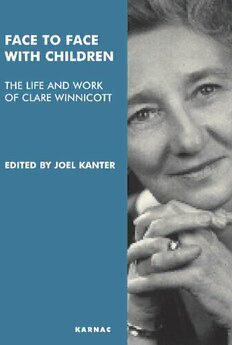
Face to Face with Children: The Life and Work of Clare Winnicott PDF
Preview Face to Face with Children: The Life and Work of Clare Winnicott
FACE TO FACE WITH CHILDREN FACE TO FACE WITH CHILDREN The Life and Work of Clare Winnicott Edited by Joel Kanter Forewords by Jeremy Holmes Brett Kahr KARNAC KARNAC LONDON NEWYORK COPYRIGHT ACKNOWLEDGEMENTS Jason Aronson for permission to reprint “D.W.W.: A Reflection”, from S. Grolnick & L. Barkin (Eds.), Between Fantasy and Reality: Transi- tional Objects and Phenomena (New York: Jason Aronson, 1978) [chapter 13]. British Association of Social Workers for their kind permission to re- print “Casework Techniques in the Child Care Services”, Case Conference, 1 (9): 3–15 (1955), and Social Casework, 36 (1): 3–13 (1955) [chapter 6]; “Face to Face with Children”, from J. King (Ed.), New Thinking for Changing Needs (London: Association of Social Work- ers, 1963) [chapter 7]; and “Communicating with Children—II”, Social Work Today, 8 (26): 7–11 (1977) [chapter 9]. Alan Cohen for permission to reprint “Child Care in Oxfordshire: Interview with Alan Cohen” [chapter 5]. Institute of Psychoanalysis, for permission to reprint “Fear of Break- down: A Clinical Example”, International Journal of Psycho-Analysis, 61: 351–357 (1980) [chapter 17]. Kay McDougall for permission to reprint “The Development of In- sight”, from C. Winnicott, Child Care and Social Work (Hitchin, Hertfordshire: Codicote Press, 1964) [chapter 11]. National Council of Voluntary Child Care Organizations for permis- sion to reprint “Communicating with Children—I”, Child Care v Quarterly Review, 18 (3) (1964) [chapter 8]; “The ‘Rescue Motive’ in Social Work”, Letters in Child Care Quarterly Review, 9 (3): 120 (July 1955), and 10 (1): 12–13 (January 1956) [chapter 10]. New Era in Education for permission to reprint “The Problem of Home- less Children”, with D. W. Winnicott (The New Era in Home and School, September–October 1944) [chapter 2]. The Squiggle Foundation for permission to reprint “DWW: His Life and Work” [chapter 14]. Taylor & Francis for permission to reprint “Introduction” from D. W. Winnicott, Deprivation and Delinquency (London: Tavistock, 1984) [chapter 4]. The Winnicott Trust and Paterson Marsh Ltd for permission to repro- duce “Development Toward Self-Awareness” from Challenges, Frustrations, Rewards, for Those Who Work with People in Need, Report on the 1964 Conference (Shrewsbury: Shotton Hall, 1964); and Toward Insight for the Worker with People (Shrewsbury: Shotton Hall, 1971) [chapter 12]; “Early Observations on Object Relations Theory” (unpublished letter) [chapter 15]; and “Lois Munro” (un- published essay) [chapter 16]. World Educational Fellowship for permission to reprint “Children Who Cannot Play”, from Play and Mental Health (London: New Educational Fellowship, 1945) [chapter 3]. CONTENTS PREFACE ix ABOUT THE EDITOR xii ACKNOWLEDGEMENTS xiii FOREWORD by Jeremy Holmes xvii FOREWORD by Brett Kahr xxiii 1 Clare Winnicott: her life and legacy Joel Kanter 1 PART ONE Oxfordshire 2 The problem of homeless children (1944) 97 3 Children who cannot play (1945) 112 4 Introduction to Deprivation and Delinquency (1984) 122 5 Child care in Oxfordshire: an interview with Alan Cohen (1980) 127 vii viii CONTENTS PART TWO Working with children 6 Casework techniques in the child care services (1955) 145 7 Face to face with children (1963) 166 8 Communicating with children—I (1964) 184 9 Communicating with children—II (1977) 198 PART THREE Social work 10 The “rescue motive” in social work (1955–56) 213 11 The development of insight (1959) 216 12 Development towards self-awareness (1964) 227 PART FOUR On D. W. Winnicott and psychoanalysis 13 D.W.W.: a reflection (1978) 237 14 D. W. Winnicott: his life and work (1982) 254 15 Early observations on object relations theory (1943) 278 16 A personal tribute: Dr Lois Munro (1974) 281 17 Fear of breakdown: a clinical example (1980) 284 PUBLISHED WORKS OF CLARE WINNICOTT 295 REFERENCES 299 INDEX 305 PREFACE The challenge of this volume is to allow Clare Britton Winnicott to emerge as a person in her own right, separate from her husband yet intimately involved with him. For those who knew her personally, and Donald as well, this is not a difficult task: her talents were recognized by almost all of them. A leader in child care and social work in Britain, through her work at the London School of Economics and the Home Office she influenced a generation of profes- sionals. However, as her main task in the last decade of her life involved the enhancement of her husband’s professional legacy, most professionals today only know Clare, if at all, as the wife of a leading psychoanalyst. Her final professional writings are centred on Donald’s life and work; many of those closest to Clare in her last years knew little or nothing about her substantial professional contributions. And, while overshad- owed by an idealized husband, Clare was also overshadowed by a devalued profession: even most social workers look outside their pro- fession for wisdom or insight. As David Howe commented: because social work arises in response to problems of everyday liv- ing, its expertise rests in gaining a thorough and sensitive under- standing of ordinary matters. The catch for social workers is that if the technical base and strength of occupation consists of a vocabu- ix
